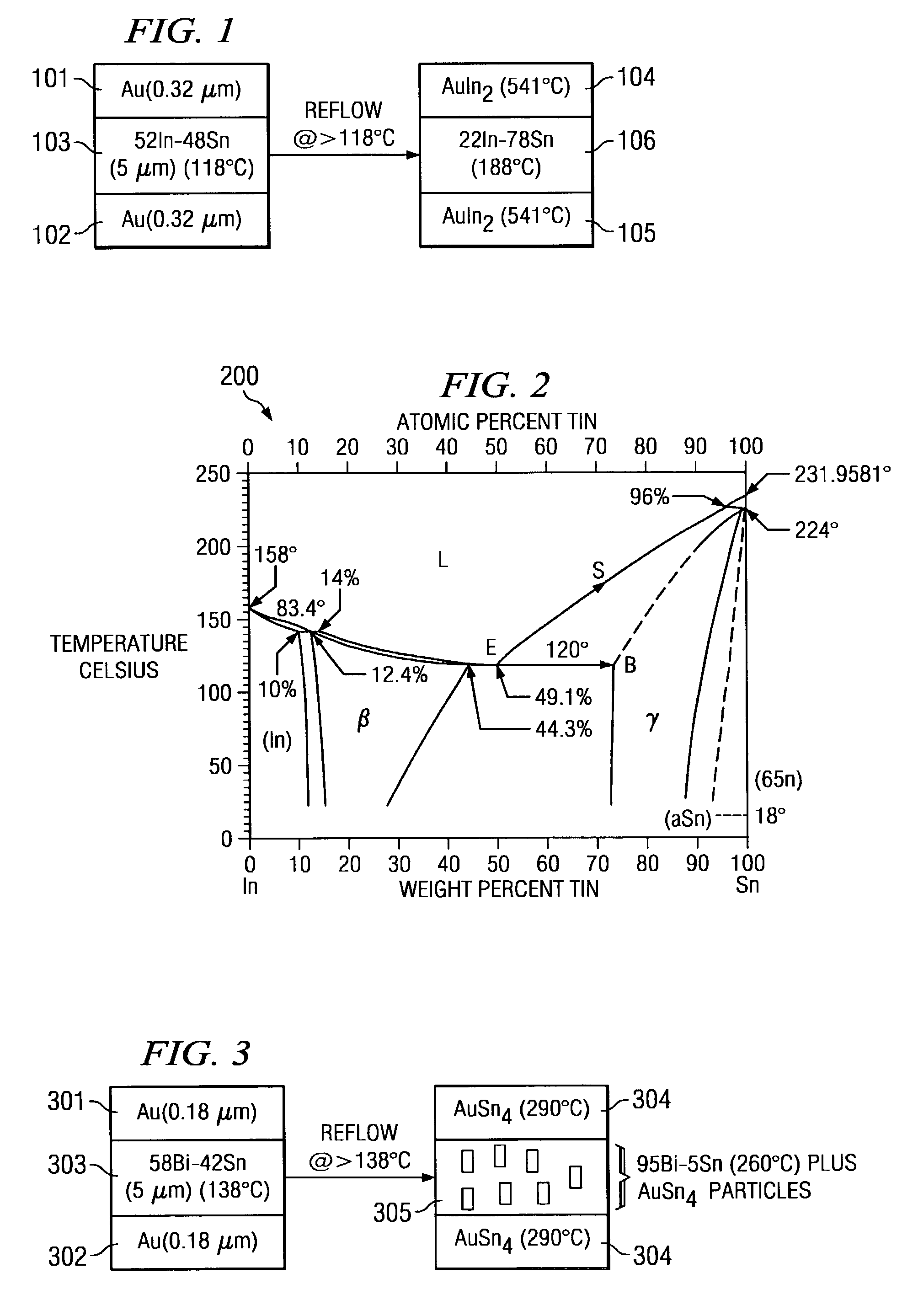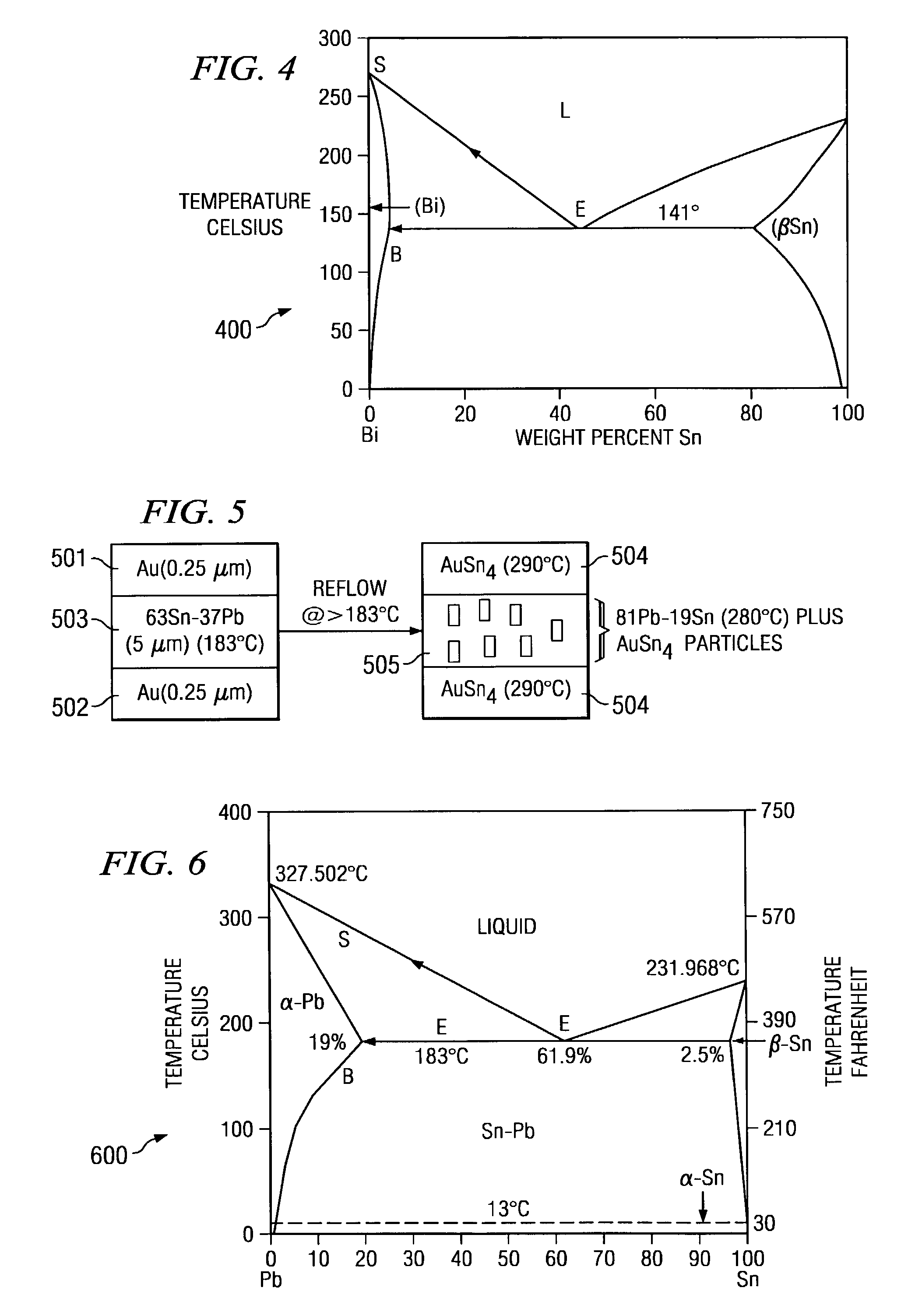System and method for hermetic seal formation
a hermetic seal and seal technology, applied in the field of hermetic seal formation, can solve the problems of thermal damage, affecting the stability of the resulting seal, and the soldering process may occur too quickly, so as to reduce thermal induced warpage, increase the melting temperature of the hermetic seal, and minimize the effect of thermal induced warpag
- Summary
- Abstract
- Description
- Claims
- Application Information
AI Technical Summary
Benefits of technology
Problems solved by technology
Method used
Image
Examples
first embodiment
[0025]In the invention, the two surfaces to be sealed are typically coated with at least 0.32 μm of Au 101, 102. 5 μm layer of 52In-48Sn 103 (note that all solder compositions are in weight percent unless specified otherwise) is coated on at least one of the surfaces. Note that all of the solder may be on one surface, or a portion of the solder may be on each surface (e.g. 0.3 μm on one surface and 0.2 μm on the other surface). The two surfaces are typically placed in contact and reflow at a temperature typically approximately 30–40° C. above the melting temperature of eutectic 52In-48Sn (118° C.). The chemical reactions and phase changes that occur during reflow would be best described in the In—Sn—Au phase diagram at 118° C. FIG. 2 approximates the In—Sn—Au diagram with the In—Sn binary phase diagram 200.
[0026]As shown in FIG. 1, AuIn2 is the intermetallic compound 104, 105 formed between Au and molten In—Sn alloys 106. The Sn concentration in AuIn2 is typically negligible. The me...
second embodiment
[0027]In the invention, the two surfaces to be sealed are typically coated with at least 0.18 μm of Au. 5 μm layer of 58Bi-42S n is coated on one of the surfaces. Note that all of the solder may be on one surface, or a portion of the solder may be on each surface (e.g. 0.3 μm on one surface and 0.2 μm on the other surface). The two surfaces are typically placed in contact and reflow at a temperature typically approximately 30–40° C. above the melting temperature of eutectic 58Bi-42Sn (138° C.).
[0028]Similar to the 52In-48Sn solder, as shown in FIG. 3, Au layers 301, 302 react with Sn in molten eutectic 58Bi-42Sn 303, forming the intermetallic compound 304, AuSn4, typically with little reaction between Bi and Au. The melting temperature of this resulting intermetallic compound is 290° C. as obtained from the Sn—Au binary phase diagram. However, unlike with the 52In-48Sn solder, the AuSn4 intermetallic compound forms not only at the Au / molten Bi—Sn interface but also inside the molten...
third embodiment
[0030]In the invention, the two surfaces 501, 503 to be sealed are typically coated with at least 0.25 μm of Au. Note that all of the solder may be on one surface, or a portion of the solder may be on each surface (e.g. 0.3 μm on one surface and 0.2 μm on the other surface). 5 μm layer 503 of 63Sn-37Pb is coated on one of the surfaces. Note that all of the solder may be on one surface, or a portion of the solder may be on each surface (e.g. 0.3 μm on one surface and 0.2 μm on the other surface). The two surfaces are placed in contact and reflow at a temperature typically approximately 30–40° C. above the melting temperature of eutectic 63Sn-37Pb (183° C.).
[0031]As shown in FIG. 5, similar to the Bi—Sn solder above, Au layers react with Sn in molten 63Sn-37Pb, forming the intermetallic compound AuSn4 504, typically with little reaction between Pb and Au. The melting temperature of this resulting intermetallic compound is 290° C. as obtained from the Sn—Pb binary phase diagram in FIG....
PUM
| Property | Measurement | Unit |
|---|---|---|
| thickness | aaaaa | aaaaa |
| thickness | aaaaa | aaaaa |
| thickness | aaaaa | aaaaa |
Abstract
Description
Claims
Application Information
 Login to View More
Login to View More - R&D
- Intellectual Property
- Life Sciences
- Materials
- Tech Scout
- Unparalleled Data Quality
- Higher Quality Content
- 60% Fewer Hallucinations
Browse by: Latest US Patents, China's latest patents, Technical Efficacy Thesaurus, Application Domain, Technology Topic, Popular Technical Reports.
© 2025 PatSnap. All rights reserved.Legal|Privacy policy|Modern Slavery Act Transparency Statement|Sitemap|About US| Contact US: help@patsnap.com



